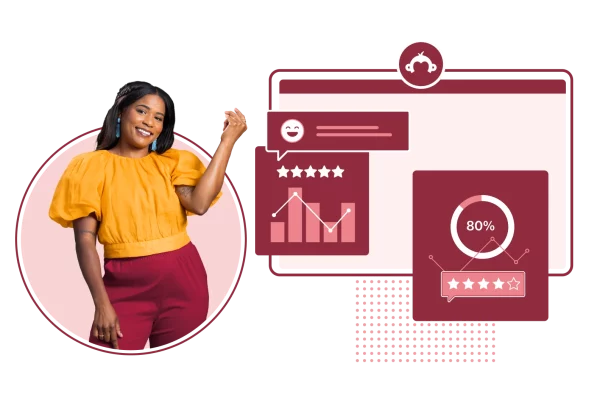What is an ideal customer profile (ICP), and how to define yours

Understanding your ideal customer is key to sustainable business growth. Creating an ideal customer profile (ICP) will align your entire organization—from sales to product development—around the unique needs of your most valuable customers.
This comprehensive guide explains what an ICP is, why it’s important, and how to create your own ideal customer profile for your business.
What is an ideal customer profile (ICP)?
An ideal customer profile (ICP) outlines the perfect customer for your business, so you can focus your time and effort where it will make the most impact. Your perfect customers are the customers that both gain significant value from your offering, and who offer you value in return through things like referrals, feedback, good reviews, and repeat business.
These customers are key for driving revenue and profits because they are more likely to buy your product or service, stay loyal to your business, and recommend you to others.
Related article: What is customer profiling?
Why is an ideal customer profile important?
An ICP is a powerful tool businesses can leverage throughout the entire customer journey—from marketing to customer success. Carefully crafting an ICP can help your business achieve sustainable growth by empowering your team to target the most suitable prospects and efficiently convert them into satisfied, loyal customers.
Ideal customer profile vs. buyer persona—What’s the difference?
While the terms "ideal customer profile" and "buyer persona" are often used interchangeably, they serve different purposes in your marketing strategy.
What’s a buyer persona?
A buyer persona is a detailed description of an individual who represents your target audience. Unlike the ICP, which focuses on the ideal company or customer segment, a buyer persona zooms in on the individual level. A buyer persona will often include very specific demographic details, behavioral traits, motivations, and goals.
What's the purpose of a buyer persona?
The main purpose of a buyer persona is to humanize the marketing and sales efforts, providing a clear picture of who the customer is, what they value, and how they make purchasing decisions. This allows businesses to craft more personalized and effective marketing messages.
Differences between ICP and buyer persona
The key difference between an ICP and a buyer persona lies in their focus. An ICP identifies the most valuable segment of customers from a broader business perspective, while buyer personas hone in on the characteristics and behaviors of individual customers within that segment. Both are essential for a holistic marketing strategy, but they serve different stages of the marketing and sales funnel.
For those looking to deepen their understanding, exploring more about buyer personas can provide valuable insights into how businesses can further personalize their marketing efforts.
Who uses an ICP?

Virtually any business will benefit from identifying and understanding its ideal customers. However, having a clear ICP is especially critical for businesses that operate in niche markets or have a limited budget, as it allows them to focus their resources where they are most likely to see a return on investment (ROI).
Marketing and Sales
Knowing your ideal customer can help marketing teams develop compelling and highly-targeted messaging to attract the right customers. When new leads come in, having a solid understanding of your ideal customer can help your marketing team quickly decide if a lead is likely to buy from you and only route highly qualified leads to your sales team for follow up. As a result, both marketing and sales can spend their time and resources focusing on prospects that are a great match for what your business can do and what your prospect hopes to achieve.
Customer Success
Clarifying your ideal customer can also help you avoid going after clients that won’t be valuable to your business long-term. For example, attracting a customer whose needs exceed your product’s capabilities will likely cost you in the long run. While you may be able to close the deal with a lower-fit prospect, these customers can quickly drain your customer support resources and take time away from customers who are a better match.
Product Development
Finally, defining your ICP can help you more effectively steer your product roadmap. When you deeply understand your ideal customer, you can continuously improve and expand your product offering to deliver more value, capture more wallet share, and improve customer satisfaction and retention metrics.
Benefits of identifying your ICP
Identifying your ICP can dramatically streamline your marketing and sales processes, making them more efficient and effective. The following are several key advantages of identifying your ideal customers:
Build a more powerful brand
Understanding your ICP can help you identify what matters most to your target audience. When you understand your ideal customers' pain points, interests, and preferences, you can produce solutions and messaging that resonate with them. Over time, prospects will begin to look to your brand as a trusted resource for valuable solutions and insights.
Improve your marketing efficiency and ROI
Crafting an ideal customer profile helps your marketing teams pinpoint exactly who is most likely to convert. With precise targeting, you can avoid “spray and pray” tactics, ensuring your marketing and sales strategies are more efficient and cost-effective.
Optimize your product roadmap
An ICP guides product development and service offerings by clarifying who you are serving and what they truly need. This makes it possible for product teams to prioritize the innovations and improvements that will make the most impact and set the business apart from competitors. When your product roadmap is built around your ICP, you can position your product as not just another option in the market, but rather a tailored solution that speaks directly to your audience's needs.
Enhance customer satisfaction and loyalty
By focusing on the needs and expectations of a well-defined ICP, businesses can deliver experiences and solutions that exceed customer expectations. This alignment between what customers want and what you provide naturally leads to higher satisfaction rates. Satisfied customers are more likely to become repeat buyers and brand advocates, enhancing customer loyalty and forming a solid foundation for long-term relationships.
How to create an ideal customer profile
Creating an ICP requires thoroughly understanding your current and potential customer base. Here’s how you can develop an effective ICP.
Conduct market research
Market research is crucial for understanding the broader market landscape, including competitors, industry trends, and potential customer segments. Your goal is to understand what it is that you do best. What is the key problem you are solving within the market? Who can benefit most from your solution?
For example, if your company offers website-building software, you might consider if your solution is best suited for individuals building a single website for themselves or an agency building hundreds or even thousands of websites on behalf of their clients. You’d then look at what other software in the web building space is doing and who their solutions are best suited for. This can help you narrow down your niche and competitive differentiation.
Analyze your existing customer data
It’s a great idea to take a look at your existing customer data to pinpoint the types of customers that see the most success. Which customers are most loyal to your business? Which ones deliver the highest lifetime value (LTV)? Who are your biggest brand advocates?
One way to capture this information is by reviewing your customer feedback metrics, including your Net Promoter Score® or Customer Satisfaction Scores (CSAT) scores, as well as qualitative insights from product reviews or product feedback surveys. These can help you understand which types of customers consistently have the highest satisfaction scores and are the most vocal in sharing positive feedback about your brand and products.
From there, you can identify the commonalities between all of your current best and happiest customers—a fantastic starting point for your ICP. You can drill down into characteristics like:
- Revenue or company size Is your product or service best for local small-to-medium businesses (SMBs), fast-growing VC-funded startups, or multinational enterprises?
- Budget: What are your best customers willing to spend? And are you getting the ROI you need?
- Industry: Are there specific verticals that are especially successful with your solution? Are there verticals that are less successful?
- Geography: In what regions are your most loyal customers based?
Develop customer personas
Based on your analysis, you can now start to create detailed customer personas that represent your ideal or “good-fit” customers. These customer personas will help you tailor your marketing, sales, and product development efforts.
Prioritize and segment
Not all customers are created equal. You might have identified several different customer profiles that could be a great match for your business. However, with limited time and budget, it often isn’t possible to go after every segment at once. You’ll need to prioritize your customer segments based on their value to your business and focus your efforts accordingly.
Close the feedback loop, collaborate, and iterate
Finally, keep in mind that an ICP is not set in stone. Your ideal customer profile can and should evolve as your business grows and as you gather more data. Be sure to collaborate across teams and regularly update your ICP based on customer feedback and evolving trends in your market.
Use surveys to conduct market research and discover your ideal customer profile
Ideal customer profiles are invaluable to teams across your organization. Profiles align teams to your ideal customer’s needs, allowing your company to create customer-centered solutions.
Start conducting market research with our Market Research Survey Template to gain insight into the market landscape and identify your company’s ideal customer.
To dive deeper into creating effective marketing strategies, see SurveyMonkey for Marketing.
Net Promoter, Net Promoter Score, and NPS are trademarks of Satmetrix Systems, Inc., Bain & Company, Inc., and Fred Reichheld.
Discover more resources

Understand your target market to fuel explosive brand growth
Brand marketing managers can use this toolkit to understand your target audience, grow your brand, and prove ROI.

Product marketing trends for 2024
New insights on product marketing trends and how product marketing teams are focused on personalization and customer-oriented actions

Top product marketing trends
Explore the latest product marketing trends, from AI to more personalized outreach. Uncover how product marketers will tap into multi-channel marketing, and more

3 ways to boost business growth by connecting SurveyMonkey and HubSpot
See how users are taking action on survey data to improve customer experience with the SurveyMonkey app for HubSpot.